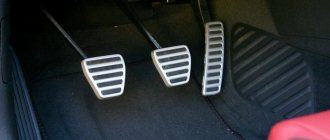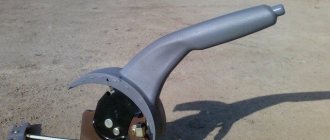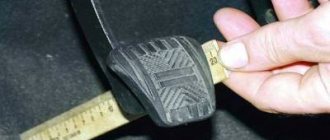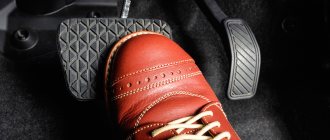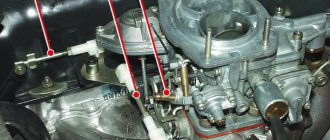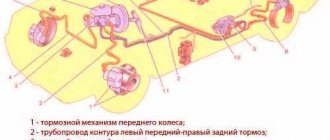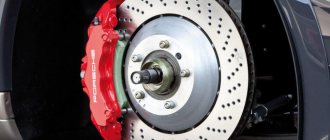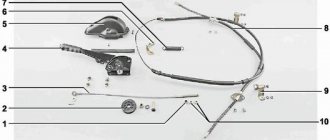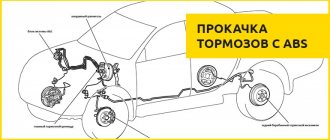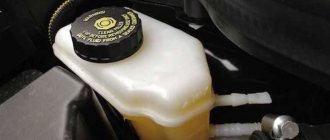The heel to the floor or the brake pedal slowly stops working. An article on a fairly relevant, even very important topic. Because no matter what the car is, this can happen even to a Bugatti or Porsche.
Anyone who has driven a car for a long time knows how to drive a car if the brakes do not work. This is a tank capable of knocking down everything in its path. If the speed is low, it is possible to hit the fence, but otherwise serious damage or accidents are inevitable. But this is nothing more than a heap of metal compared to human life.
The main thing is not to panic in such situations. I want to believe and obey this, but, as they say, we learn from our mistakes. Therefore, it’s unlikely to work without panic. In this article we will look at what is the source of the breakdown and how to fix it.
Causes of failure and elimination
The brake pedal slowly stops working, what should I do? First, let's find the source of the problem.
- Critical fluid level in the system;
- The liquid is of poor quality;
- Damage to the master cylinder;
- Improper replacement of brake pads;
- Low quality washers;
- The level of approval is not at the required level;
- Aging of pedal metal;
- Problems with the vacuum pump.
The foot brake pedal is the most reliable of all. It breaks only in extreme cases. The brake mechanism itself is structurally very complex, so it is up to you to decide whether you repair it yourself or take the car to a car repair shop.
Bad brake fluid is the main problem with our brakes. Over time, this causes internal cracks to corrode and the hose to rupture. This can be checked by unscrewing the old hose, blowing it out and doing the same with the new one. The difference will be felt. The same goes for brake seals.
A rusty pedal can be easily removed and replaced with a new one. The lever should move freely, without force, pulling it back all the way. If this is not the case, look for faults.
Using the foot pedal, you can check the correct piston play. Press it in with your hand until it stops and release it. The return should be in two stages: the first part is easy halfway, and the second part is slightly tense (as if catching up). In fact, the bar is catching up. If there is no such barrier, then the gap is too small. More often, this disease is inherent in the vast majority of local cars.
The malfunction can also occur after installing new pads. Don't worry, this is a natural phenomenon. Simply add fluid to the recommended level. It is impossible to immediately pour the required amount, because the washers do not work yet. Pour in and everything will work out. See “How and where to add brake fluid.”
Twitching and swaying. This is a common occurrence with new brake pads. You need to travel about 400-600 km. So that the discs eat the contour in the pads. Then such sensations on the pedal will subside. If the story doesn't end there, look for a problem in the brake disc. Most likely it is deformed. Requires complete replacement or sanding.
There is no problem with the vacuum pump itself unless it breaks and breaks the housing. The reason, most likely, is the cracks on the snakes, and as a result - airiness.
And here it is, the brake pedal is slowly failing, what should I do? The list of reasons is exhaustive. We hope that many drivers will find our recommendations useful. Share your tips and tricks. Let's work together to understand complex problems and find solutions.
From this material you will learn why the brake pedal does not work, how to find the cause in different individual cases and how to solve the problem.
If your car's brake pedal is damaged, there may be several reasons for this:
- brake fluid leak
- master cylinder failure
- air in hydraulic brake system
- brake fluid needs to be replaced
- improper pumping or replacement of brake fluid
- Pedal brakes without pressure immediately after replacing pads
- when the engine is running - turn on the vacuum brake booster
- operation of the anti-lock braking system
Why the brake pedal fails: reasons
What work needs to be done depends on the car model, its mileage and operating conditions:
- A leak. When you press the pedal, it goes through damage in the system, air gets inside, which cannot transfer force to the wheels, and the brakes disappear. Check the level in the expansion tank; most likely, the container will be empty. Then inspect the GTZ and the calipers on the wheels. The location of the leak is usually clearly visible - there will be a wet spot under the wheel or under the hood. You can invite an assistant to apply the brakes while you watch where exactly the leak is coming from. The problem is solved by replacing the damaged unit.
- Air in the circuit. There may not be any damage. Air enters the lines when the fluid level is insufficient, when the expansion tank becomes empty when the pedal is pressed hard. Air pockets form in the pipelines, which are compressed and do not allow force to be transmitted, while the liquid level may remain stagnant. The repair consists of bleeding the system.
- Poor quality or untimely replacement of the fluid - a special composition of glycol components and additives that protect seals and system components from the inside. If there are no additives or the liquid has not been changed for several years, its properties are impaired. It begins to destroy the seals, which leads to leaks. It will be necessary not only to replace damaged parts, but also to fill in new fluid and pump the system.
- Failures of the GTZ can be associated with leakage through the seals or wear of its components. If the first option can be found out without any problems, then the second can only be discovered after disassembling the part and inspecting the internal elements. This method is resorted to if other measures have not brought results. In some models, the seals can be replaced, but most often the gas turbine engine is replaced entirely.
- Weak force transmitted from the pedal to the main brake cylinder. Sometimes the reason is that the gap is too large, wear of some components may also be detected, etc. It is not difficult to diagnose this problem - the brakes begin to work at the very end and the system simply does not have enough range for normal braking. Features of solving the problem depend on the design of the pedal assembly.
- Large gap between brake pads and drum. Found on cars with a rear drum system. When installing elements, they must be positioned so that they are located as close as possible to the drum and, when pressed, ensure strong contact of the surfaces. If the adjustment is not made, the pads simply do not reach the surface or the force is too weak to provide normal braking.
- Worn calipers or fasteners that hold the pads. All parts usually fit together very precisely and any violations lead to the pedal falling through and the brakes becoming much worse. It is necessary to remove the wheels and check each unit separately. If something is loose in it or there is no rigidity, repairs are carried out or the part is changed entirely.
- Worn brake pads. Some drivers drive until the pads wear down to a metal plate, causing the brake cylinder to extend all the way, but even in this position it cannot operate effectively. This option can be determined by weakening the brakes. Often there is an extraneous noise when you press the pedal, when metal rubs against metal. The problem is solved by replacing the pads.
- Overheating of components. During active driving, especially on serpentines and hills, and frequent use of the brakes, they can overheat, which will cause pedal failure and a decrease in the efficiency of the system. Often there is a hum when you press the pedal. In this case, it is better to stop and let the units cool down. No repairs will be required.
- Not ground in system elements. Most often, after replacing the pads, they need time to get used to the discs. At the same time, vibration or beating may be observed when pressing the pedal, and it may fail, albeit slightly. The problem usually goes away after 100-500 km. It all depends on the driving characteristics and the quality of the installed pads.
By the way!
If the vacuum booster membrane is damaged, the pedal becomes very hard, but the brake does not disappear. For them to work effectively you will have to press much harder.
Master cylinder malfunction
If there is no brake fluid leak, a symptom indicating the possibility of a breakdown of the GTZ unit is that the pedal slowly stops working, while holding it down, only after the second or third stroke can it stand firmly. Failure of the master cylinder is the result of wear of the piston sealing elements and the inability to maintain high pressure in the hydraulic system for effective operation of the brake mechanisms. Thus, the liquid returns back to the reservoir. The problem is solved by replacing the device or restoring it with a repair kit.
Brake system elements
The brake system is at the same time one of the simplest and at the same time complex technical components inside a car. It has several particularly important elements, which are listed in the table below.
Table. Structure of the braking system.
| Element | Purpose |
| GTZ | Brake cylinder – master. It is responsible for separating the so-called brake circuits, as well as for directing forces to all wheels. |
| Brake pedal | An element with which the driver controls the operation of the braking system. With its help, the braking command from the one who is driving gets to the other nodes. |
| RCC | These are working cylinders whose purpose is to exert a certain action directly on the mechanical elements of the brake system. These include calipers. |
| Highways | Elements that, along with pipelines, allow you to connect all parts of the system together and ensure proper circulation of the brake fluid. |
| Amplifier | A vacuum booster is needed to make the braking process more effective by increasing the pressure inside the system. |
In addition to these elements, the autobraking system includes special so-called drums or discs, as well as pads that clamp the rotating elements of the wheel.
Brake discs and pads are an integral part of the braking system
Inside the system there is also a special fluid with a certain chemical composition, which is called brake fluid. It has certain properties: for example, in the process of pressing the pedal, force is transferred from the foot to the main cylinder of the brake system, which contains this fluid. Next, the piston inside the cylinder begins to move and puts pressure on the brake compound, which transmits the force further to the so-called working cylinders, located, in turn, in the area of the car wheels. The result of this whole process is pressing the pads against the drums or (depending on the type of system) discs and slowing down the vehicle.
Brake classification
On a note! When you apply the brakes suddenly and forcefully, the pads can completely block the wheels, preventing them from rotating.
Brakes must always be in good condition.
The precise interaction of all parts of the system ensures smooth and correct braking of the vehicle. If something is not working as it should, then there is a risk that it will not brake and an accident will occur.
Large amount of water in brake fluid
One of the properties of brake fluid is its hygroscopicity, that is, the ability to accumulate moisture. With a large amount of it, the boiling point of the liquid drops significantly. During heavy braking, overheating leads to a significant decrease in braking efficiency. For this reason, the brake fluid must be periodically replaced with new one.
Since the indicator visually darkens, there are also special devices that determine the percentage of humidity. Inspection rules for most cars require that brake fluid be replaced every 40,000 km or every 4 years.
Improperly performed fluid change or brake bleeding
If we have pumped the brakes and the pedal is still faulty, then the procedure has not been followed. The sequence of operations differs for right-hand drive and left-hand drive vehicles, and each vehicle model may have its own characteristics. In this case, check the correct operation of the device or contact a specialized service center.
Many experts prefer to use special pumping devices for pumping. Thanks to this, it is possible to create higher pressure in the system and make the hydraulics work as efficiently as possible. Once the brakes are pumped in the normal way, pressing the brake pedal will often cause the brakes to slow down and need to be repeated.
Let's get started
Pumping is carried out in a certain sequence. The diagram is criss-cross. First, the air is pumped out of the rear right wheel. Then - from the front left. Next they move to the rear left and then to the front right disc. So, we tear off the bolts from the desired wheel, put the car on a jack and install the stops. It is impossible to lift on clamped blocks. Next, open the hood and add fluid to the maximum. We will need an assistant who will press the pedal several times on command.
At the end you need to keep the brake in the floor. At this time, you open the fitting and watch how the liquid flows through the pre-installed hose. First it will be saturated with air. With subsequent attempts (the procedure must be repeated several times), it will acquire the consistency of liquid. The number of repetitions depends on the volume of air that was in the system. The procedure should be stopped when clean liquid, without bubbles, does not flow from the hoses. Next, remove the silicone pipe and tighten the fitting. Let's move on to the next wheel. And so on until the air is removed from all circuits. An important point - periodically check the fluid level in the tank while pumping (it will drop slowly but surely). It should not be allowed to be at a minimum. Otherwise, the system will “sip” air and the procedure will have to be repeated again, on all wheels.
Operation of vacuum and ABS
In some cases, if the brake pedal fails from time to time, it may be due to components in the braking system or related active safety systems.
If the brake pedal drops slightly when starting the engine, this is normal and is due to the operation of the brake booster. Works only when the engine is running. The driver must significantly reduce the force on the brake pedal to apply the brakes.
Releasing the ABS system on a slippery surface also involves momentary play and jerking of the brake pedal, which means that the force applied to the pedal is insufficient and therefore the brake discs may slip. The car's wheels are not blocked and the car remains controllable.
If the brake system malfunction is intermittent and episodic, this is the main danger while driving - the brakes may not work over time. Determining the real cause of a brake pedal problem may require a detailed brake inspection to ensure all system components are working properly.
It is difficult to overestimate the correct operation of the braking system and not to be deceived by the popular proverb that daring drivers do not need brakes... Nonsense! Considering the speed and capabilities of modern cars, as well as congested highways, driving without brakes is synonymous with suicide.
It is not difficult to identify a faulty brake system, but it is important to do it before leaving the garage or parking lot, otherwise there is no chance of avoiding an accident. Brake problems manifest themselves in a variety of ways, such as ineffective braking, a rough brake pedal feel, or play in the brake pedal. We will talk about the latter phenomenon today. Went.
Before driving, check the condition of the brakes. To do this, it is enough to press the brake pedal several times, if at the same time you do not feel some flexibility, but instead feel that the pedal is not working - the brake system is not in order and you cannot pass in any case! The same thing happens if the brake pedal does not return to its original position.
General information about the brake system
To better understand why the brake pedal fails in a given situation, it is important to first understand how the entire braking mechanism works and how it all works. By the way, most often the brake system in modern cars is hydraulic, and all the main components and problem areas in it are similar in different vehicle models. In this case, the principle of operation of the brakes is that inside the closed system there is a special incompressible fluid, which is called brake fluid.
Brake system design
On a note! Previously, the so-called mechanical braking system, consisting of various cables and drives, was most often used on cars, but automotive enterprises abandoned its use a long time ago.
Why the brake pedal fails
Despite the fact that mechanics are much better than hydraulics in terms of reliability, their performance is still much lower, and it does not work as smoothly as we would like. Especially with modern powerful engines and increasing speeds. Mechanics are simply not able to cope with the modern level of tasks assigned to it - it cannot stop the car as smoothly, efficiently and safely as we would like.
How should the brake pedal move?
There is also a pneumatic braking system, but it is used only on special vehicles - trucks, heavy and powerful equipment, buses, and so on. The system is effective, but is not suitable for passenger cars, as it is too heavy and bulky.
The simplest diagram of air brakes for a car
